This post may contain affiliate links. Please see our disclosure policy.
Chamomile jelly is perfect on biscuits and scones, and it’s just another way to enjoy this tea-time favorite from the herb garden.
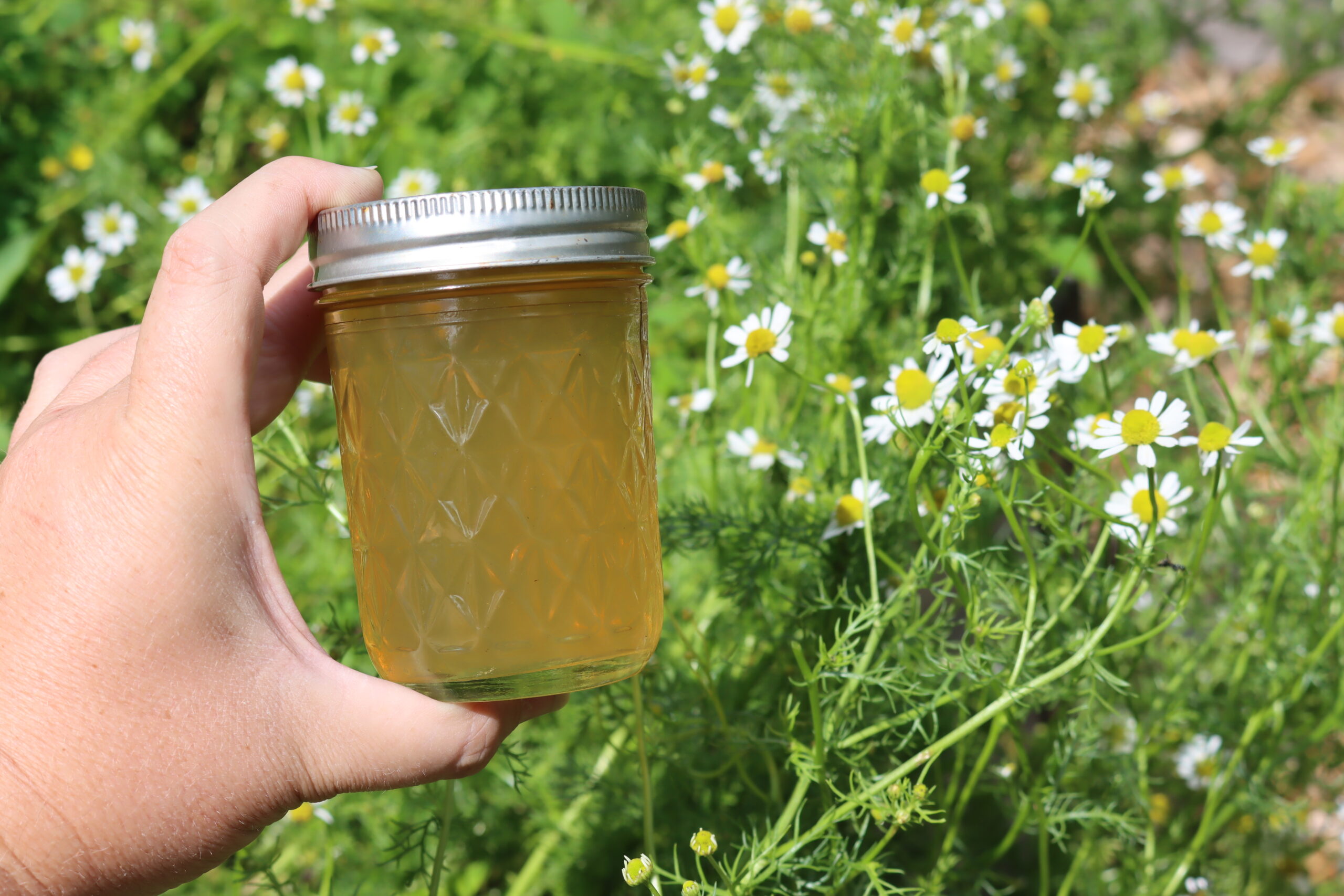
Table of Contents
- A Quick Look at the Recipe
- What does Chamomile Jelly Taste Like?
- Harvesting Chamomile For Flower Jelly
- Ingredients for Chamomile Jelly
- How to Make Chamomile Jelly
- Canning Chamomile Jelly
- Chamomile Jelly Variations
- Chamomile Recipes
- Flower Jelly Recipes
- Chamomile Jelly Recipe
- Full Sugar or Low Sugar
- Flower Jelly Recipes
- Herbal Jellies
Chamomile is usually associated with herbal tea, but this fragrant herb is wonderful in all manner of recipes, including a homemade chamomile jelly.
I particularly love this sunny floral jelly on biscuits and scones, where the sweet floral flavor compliments the buttery texture of the baked good. This jelly also makes wonderful jelly thumbprint cookies, too!
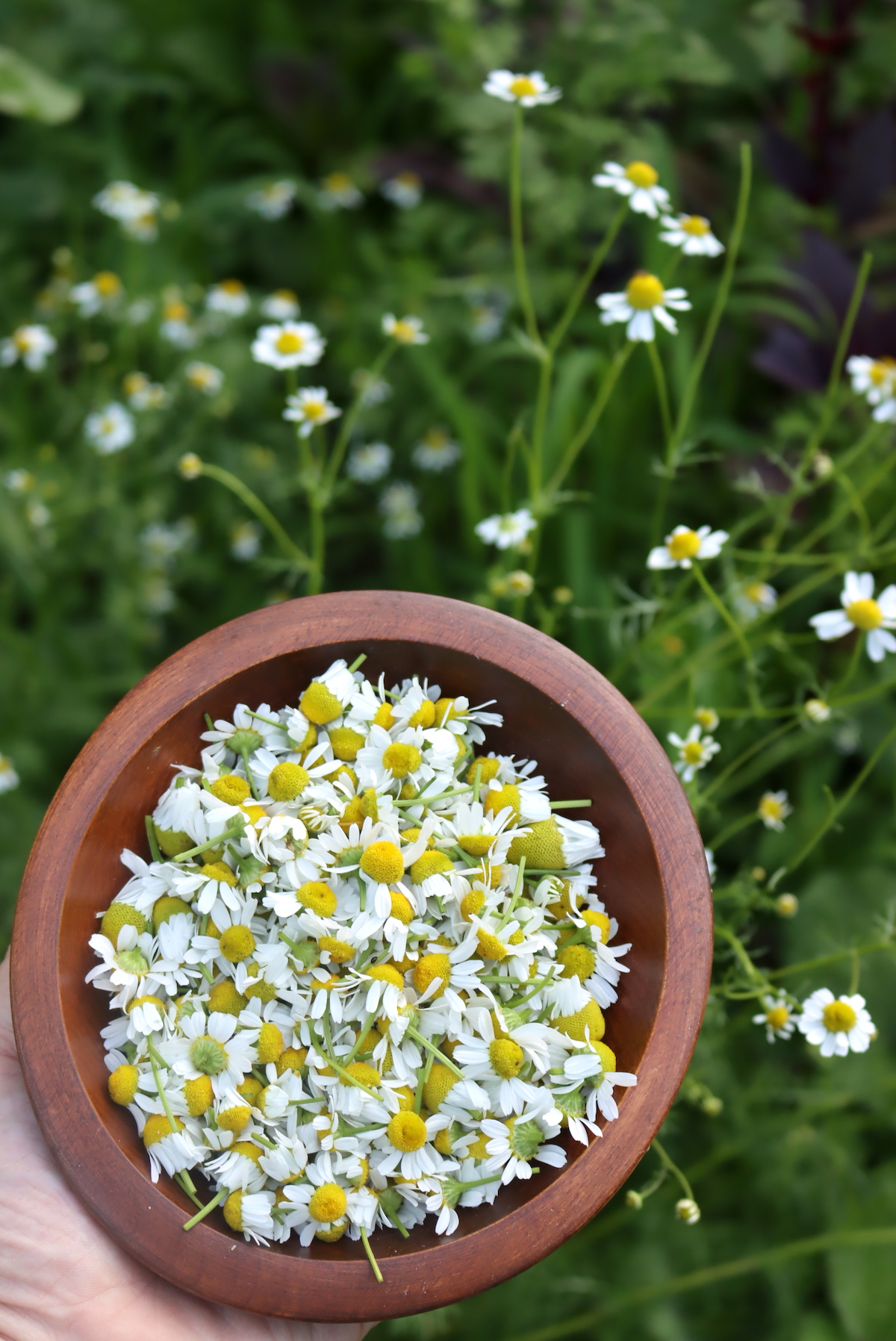
A Quick Look at the Recipe
- Recipe Name: Chamomile Jelly
- Recipe Type: Flower Jelly Recipe
- Canning Method: Waterbath Canning
- Prep/Cook Time: 30 Minutes
- Canning Time: 10 Minutes
- Yield: 4 to 5 half pint jars
- Jar Sizes: Quarter Pint, Half Pint or Pint
- Headspace: 1/4 inch
- Ingredients Overview: Edible Flowers, Water, Lemon Juice (not optional), and sugar
- Difficulty: Easy! You’re basically making a quick tea and setting it with pectin.
- Similar Recipes: The process is very similar to making other summertime floral jellies, including Clover Jelly, Calendula Jelly, Elderflower Jelly, Nasturtium Jelly, Borage Jelly, or Rose Petal Jelly.
What does Chamomile Jelly Taste Like?
Many floral jellies have somewhat cryptic flavors that are a bit unexpected. Pansy jelly, for example, tastes like fresh spring berries. Forsythia jelly tastes an awful lot like sweet summer peaches.
The sweet floral flavor of chamomile, though, is unmistakable. Chamomile jelly doesn’t taste like anything else, just concentrated aromatic comfort with a sweet sunny side.

Harvesting Chamomile For Flower Jelly
If you’re harvesting fresh chamomile, choose blososms that are fully developed, but still have their petals. As the blossoms lose their petals, they also start to lose their wonderful flavor.
You can also use dried herbal tea in place of fresh chamomile in this recipe. In that case, you’d want to use about 2 to 3x as much as you’d normally use for a cup of chamomile tea, so that the flavor really comes through in the finished batch.

Ingredients for Chamomile Jelly
To make a flower jelly from chamomile flowers, you’ll need freshly harvested blooms (or dried tea), plus water, sugar, pectin, and a bit of lemon juice.
For a 4 to 5 jar batch (8 oz each), you’ll need the following:
- 1 to 2 cups fresh chamomile blossoms (or 1/2 cup dried chamomile)
- 4 cups water
- 2 tbsp lemon juice (or ½ tsp citric acid)
- 1 to 4 cups sugar *see note
- 1 box (1.75 oz) pectin (Regular or Low Sugar)
The actual amount of chamomile to use will depend on your personal tastes, and the chamomile in question, as some is a long stronger tasting than others.
I’d suggest brewing a batch with about twice as much as you’d normally use for herbal tea, as it takes a bit more to get the flavor to come through in chamomile jelly.
Lemon juice helps balance the sweetness and brings out the floral notes of the chamomile. It also lowers the pH for proper jelly setting and canning safety. If you prefer a neutral option, citric acid powder (dissolved in water) can be used instead of lemon juice. Citric acid is much stronger, so use ¼ teaspoon for each tablespoon of lemon juice in a recipe.
For sugar amounts, Regular Sure Jell pectin (and other “normal” pectin types) requires 4 cups of sugar for every 4 cups of liquid. Sure Jell low-sugar pectin (and other low-sugar pectins) allows you to use less sugar (anywhere from ½ to 2 cups for 4 cups of liquid). If you’re using a “flex batch” pectin, then a box is equal to 6 Tbsp.
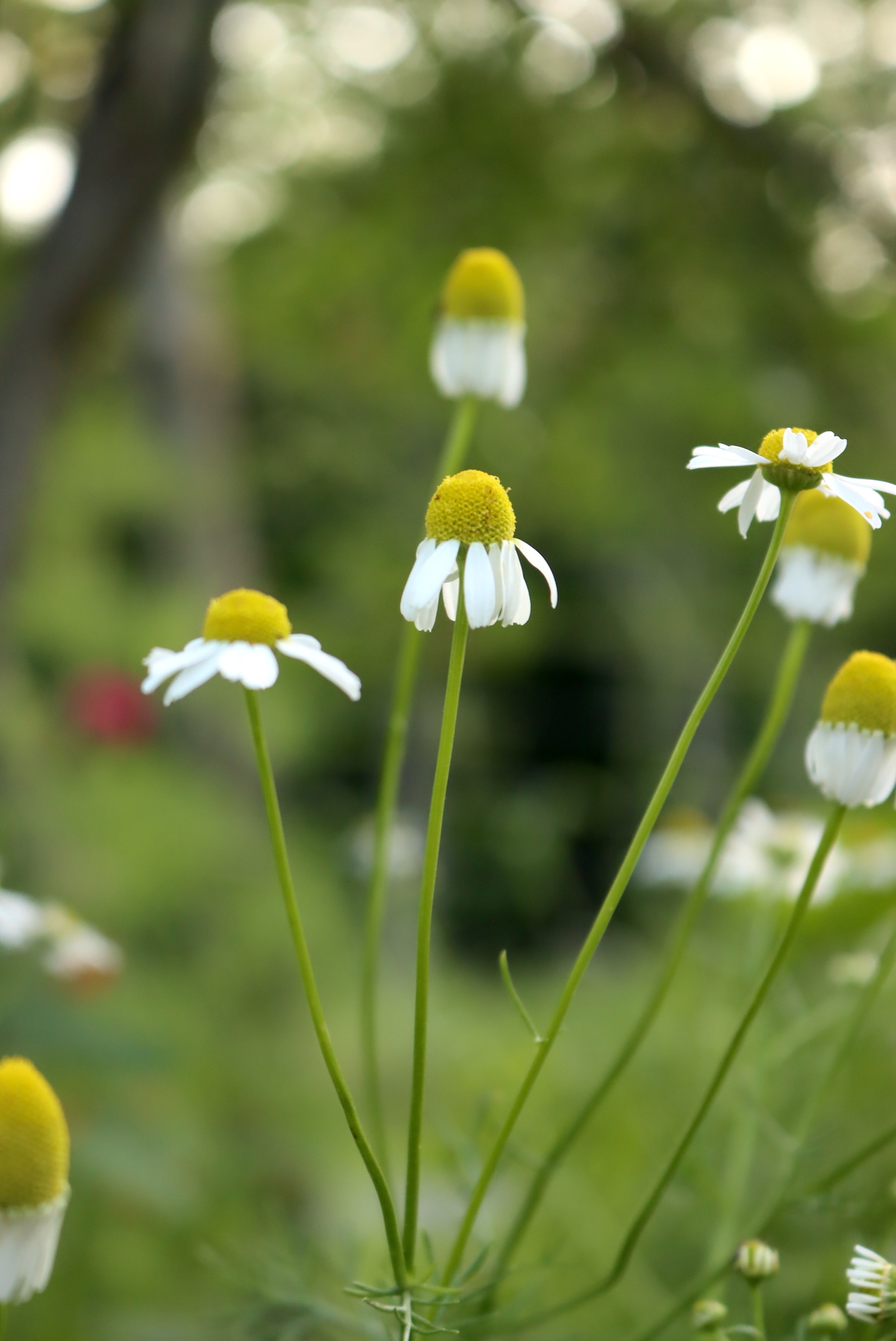
How to Make Chamomile Jelly
Making chamomile jelly is similar to other floral jellies, but since chamomile has a more potent flavor, it requires fewer flowers. For this recipe, you’ll need about 1 to 2 cups of fresh chamomile blossoms, or ½ cup if using dried flowers.
Start by harvesting the chamomile directly into a quart jar, which is the perfect size for steeping. Pour 4 cups of boiling water over the flowers, and let the mixture steep for 10 to 15 minutes. Afterward, strain the tea to remove the flowers.
Once you’ve strained the chamomile tea, transfer it into a jelly pot. Add 2 tablespoons of lemon juice to the tea, as this not only helps balance the sweetness but also helps the jelly set and makes it safe for canning. Bring the tea to a boil over medium heat.
Next, add your powdered pectin. Typically, a standard 1.75 oz box of pectin is used, such as Sure Jell, but any regular pectin will work. Stir the pectin into the tea until it dissolves completely and boil for 1 full minute.
Now it’s time to add the sugar. If you’re using regular pectin, you’ll need 4 cups of sugar for 4 cups of chamomile tea. If you’re using low-sugar pectin, such as Sure Jell Low Sugar, you can adjust the amount of sugar to your liking, adding as little as ½ to 1 cup for a lightly sweetened jelly. Stir the sugar into the boiling mixture until it’s fully dissolved, then return the pot to a full boil for another minute.
After the mixture has boiled for a minute, remove it from the heat and ladle it into your prepared jars.
Canning Chamomile Jelly
While canning is optional, it’s a great way to store your chamomile jelly for long-term use. If you prefer, you can store the jelly in the refrigerator for up to several weeks or freeze it using freezer-safe jars.
For canning, it’s important that you use lemon juice, as it helps lower the pH to make the jelly safe for preserving. Prepare your water bath canner, jars, and lids before you begin making the jelly. Once your jelly is ready, carefully ladle it into prepared canning jars, leaving ¼ inch of headspace at the top. Seal the jars with two-part canning lids.
Process the jars in a water bath canner for 10 minutes (adjust to 15 minutes if you’re at an altitude above 6,000 feet). Once the canning time is up, remove the jars and allow them to cool on a towel-lined counter.
Properly sealed and canned chamomile jelly can be stored in your pantry for up to 12 to 18 months. Be sure to refrigerate after opening.
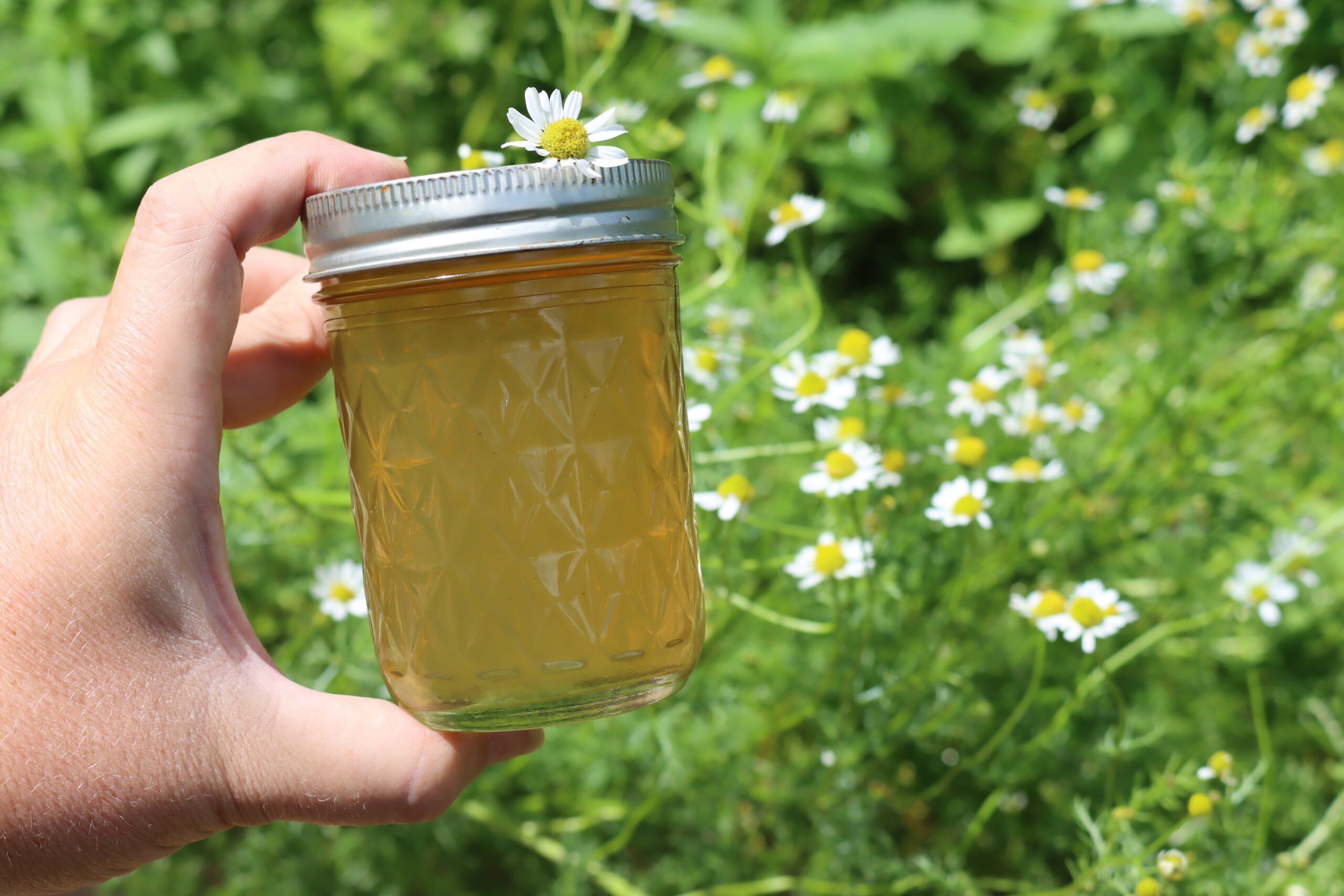
Chamomile Jelly Variations
Ball canning has a recipe for a chamomile strawberry jelly, where they simply replace the water used in tea with strawberry juice. You’ll first need to extract the strawberry juice as you would when making jelly (with a jelly bag) and then infuse chamomile leaves into the warm juice before proceeding with the jelly recipe.
Chamomile Recipes
Looking for more fun ways to use chamomile?
If you tried this Chamomile Jelly Recipe, or any other recipe on Creative Canning, leave a ⭐ star rating and let me know what you think in the 📝 comments below!
And make sure you stay in touch with me by following on social media!
Flower Jelly Recipes
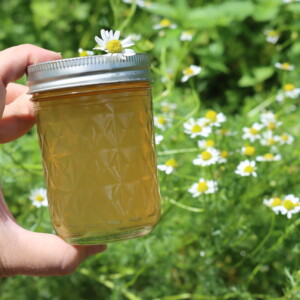
Chamomile Jelly
Ingredients
- 1 to 2 cup fresh chamomile blossoms, or 1/2 cup dried
- 4 cups water
- 2 tbsp lemon juice
- 1 to 4 cup sugar , see note
- 1 box powdered pectin, 1.75 oz pectin (Regular or Low Sugar)
Instructions
- Start by placing the chamomile flowers, whether fresh or dried, into a heatproof container. Pour 4 cups of boiling water over the blossoms and let the tea steep for about 10 to 15 minutes. Once the tea has infused, strain it into a saucepan or jam pot.
- Next, add the lemon juice to the strained tea. This is essential, not only for enhancing the color of the jelly but also for balancing the sugar in the recipe and aiding the pectin in setting properly. Additionally, the acidity from the lemon helps preserve the jelly, so be sure not to skip this step!
- Bring the mixture to a boil, then stir in the powdered pectin until it is fully dissolved. Let it boil for 1 minute before adding the sugar. (It’s important not to add the sugar before or with the pectin, as this will prevent the jelly from setting properly.)
- Once the pectin is dissolved and the mixture is boiling, add the sugar and stir until fully dissolved. Bring the mixture back to a rolling boil for another minute, then remove it from the heat. Ladle the hot jelly into prepared jars, leaving about 1/4 inch of headspace.
- If you’re canning, process the jars in a water bath canner for 10 minutes. If not canning, let the jars cool completely on the counter. Once cooled, store the jelly in the refrigerator for up to a month or freeze it for up to 6 months.
Notes
Full Sugar or Low Sugar
If using standard pectin, you must use a 1:1 ratio of liquid to sugar. That means for 4 cups flower blossom tea you'd need a minimum of 4 cups sugar to get the jelly to set. That results in a very sweet "old-fashioned" jelly. To reduce the sugar, simply use low-sugar pectin instead and then make the jelly as instructed but using less sugar. I suggest sure jel low sugar, which is very dependable. Lowering sugar will also lower yield, and the yield of 5 half-pints is for a full sugar recipe. If using Pomona's Universal Pectin, the instructions are different, as that is a 2-part low sugar pectin. Follow the instructions provided in the Pomona's box for mint jelly. If using liquid pectin, the order of operations is different (pectin is added last, sugar first). Liquid pectin also requires a lot more sugar to set (7 cups sugar to 4 cups liquid). I don't recommend liquid pectin because of the high sugar levels required for set, but it will work if that's your preference. If you have Ball Flex Batch Pectin, you’ll need 6 Tbsp. (which is equal to a 1.75 oz box of other types of pectin). That’s true for their regular and low-sugar canisters.Nutrition
Nutrition information is automatically calculated, so should only be used as an approximation.
Flower Jelly Recipes
Stock your pantry with these tasty floral jellies!
Herbal Jellies
Flowers aren’t the only plants in the garden that make wonderful jellies!
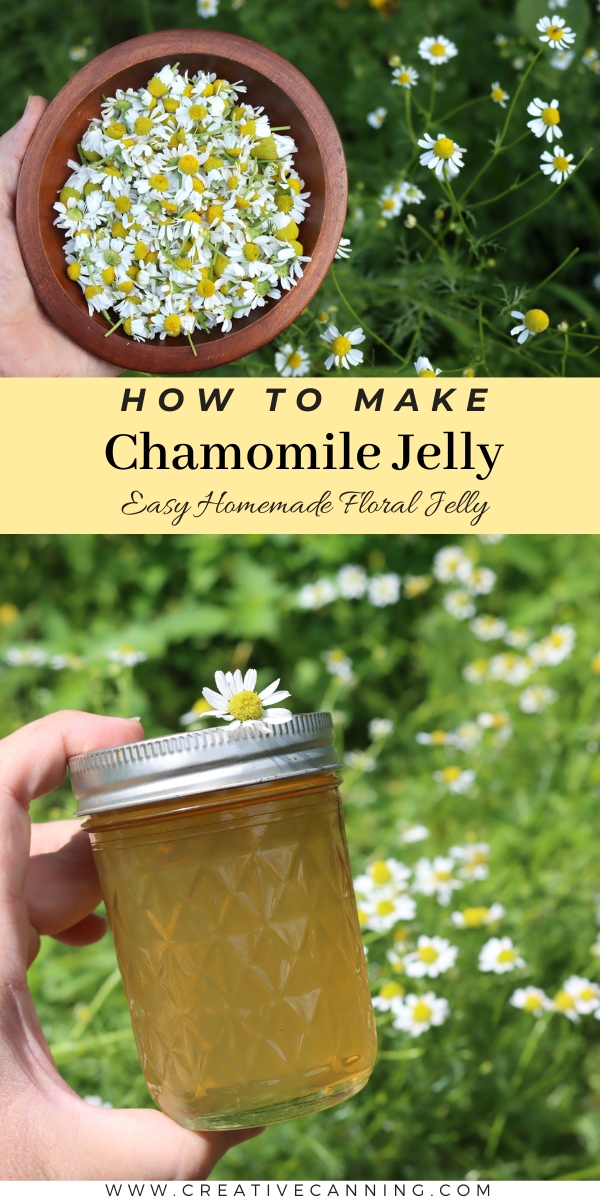
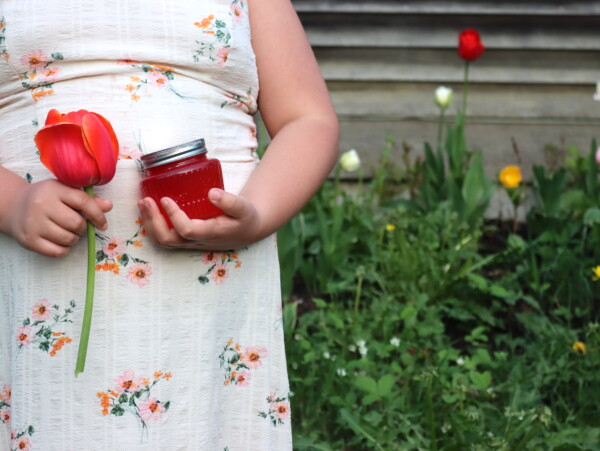

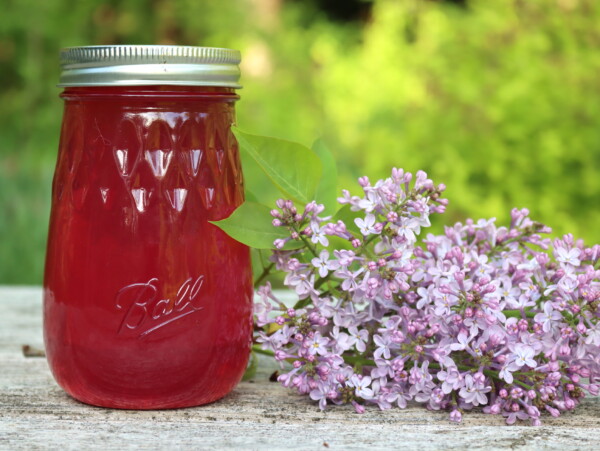

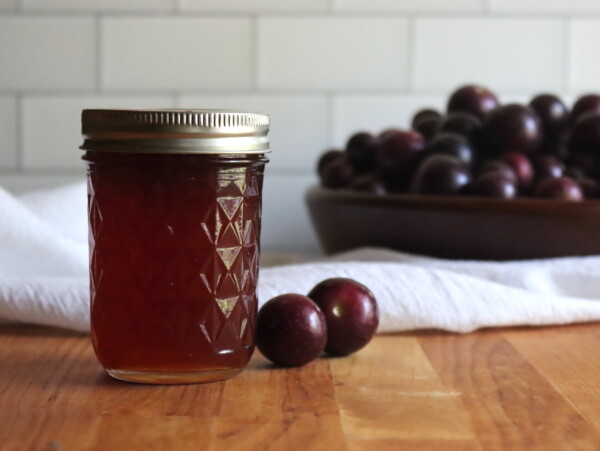
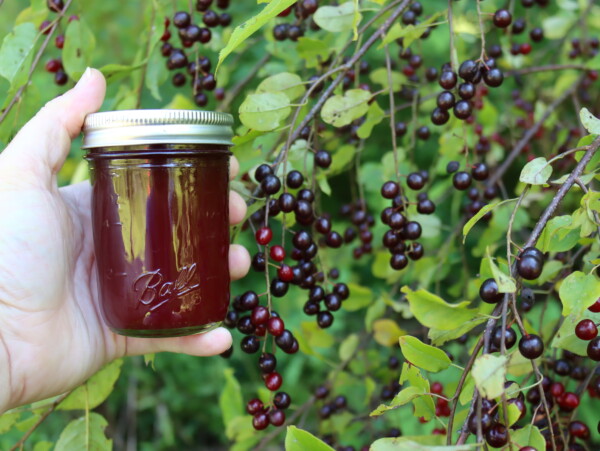
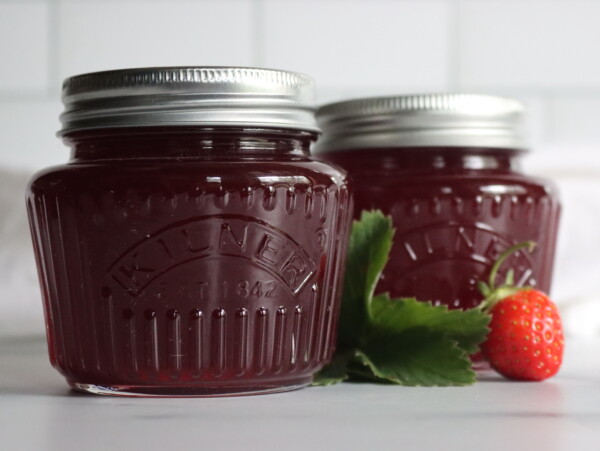
I made this today using two cups of fresh picked chamomile flowers from my garden and it’s delicious. I can’t really compare its flavor to anything I’ve ever tried as it’s a flavor all its own – light, fresh, floral and not overly sweet. I liked it so much that after I filled the jars I was scraping the pot with a spatula to get every last drop to eat! It will taste great on anything you like jelly on – toast, biscuits, thumbprint cookies, etc. Thanks for sharing this recipe! It’s really good!
I’m so glad you loved it!